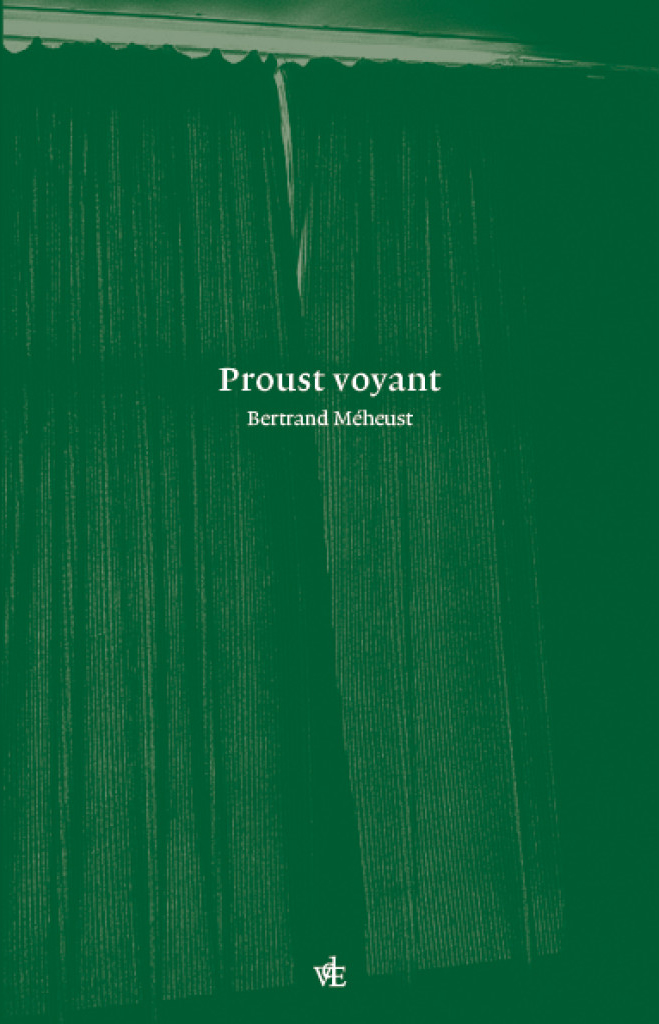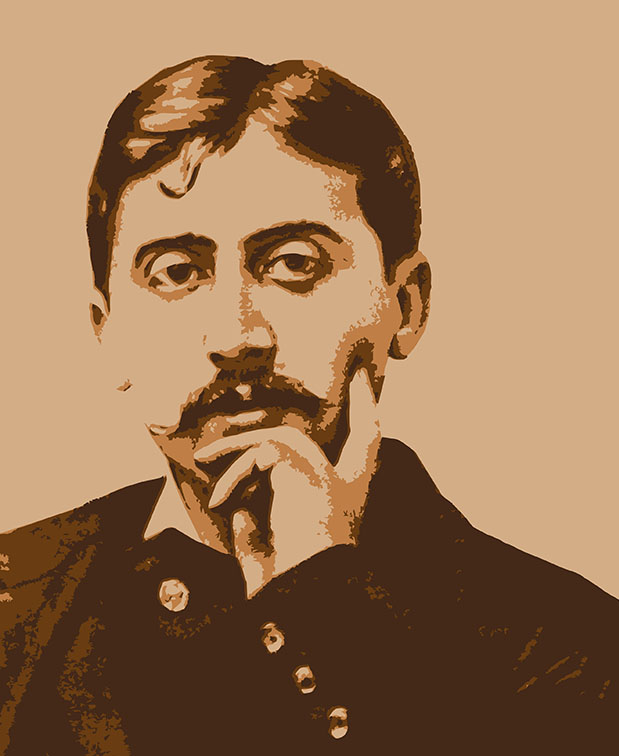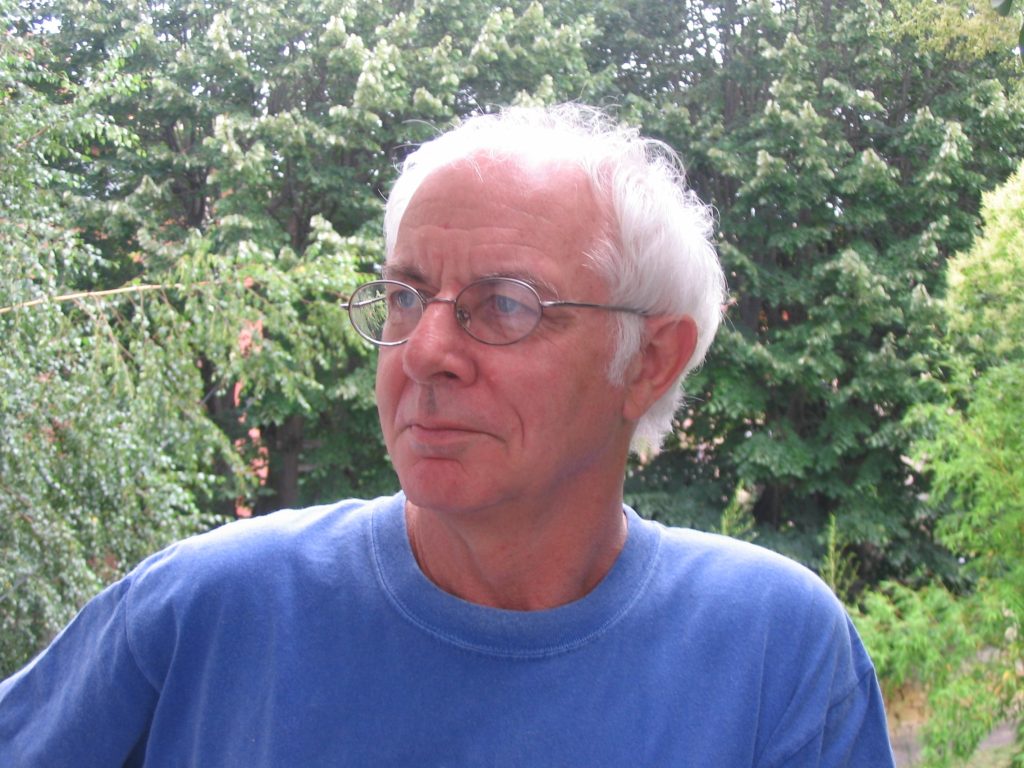
To mark the centenary of Marcel Proust?s death on 18 November 1922, philosopher and sociologist Bertrand Méheust has published Proust Voyant (1). The author, a historian of metapsychology, highlights an aspect of the work of this immense writer that has been totally ignored, as most exegetes ignore this dimension of the culture in which the novelist was immersed. His work sheds light on a hidden aspect of La Recherche du temps perdu and the mediumistic abilities attributed to Proust by those close to him.
Marcel Proust was nearly forty when he began composing his work, "an immense edifice of remembrance "In the secret of a closed room, he travelled in his mind to relive his past by transforming it through writing. If the meaning of this operation escapes us today, it was clear to those close to him, who recognised his exceptional powers of perception. His close friend, the musician Reynaldo Hahn, described him as ? enlightened medium "able to make him suddenly know the thoughts of others down to their innermost recesses, through a sudden process of psychological discernment, through a sudden illumination. ".
Some of his close friends, such as Anna de Noailles and Elisabeth de Gramont, to name but a few, considered him to be a ? indicator light He was seen as a true "spirit-reader", a man whose presence could trigger a feeling of awe and anxiety in some people (like Princess Bibesco). Should we be surprised then that, a few months after his death in January 1923, in a tribute published by the NRF, the most prestigious literary review of the time, almost half the contributors confirmed his gift of clairvoyance. And that others who had been close to him shared this view? This quote from Reynaldo Hahn sums up his abilities best: " Critics of great intelligence and knowledge have insightfully analysed Marcel Proust?s work, genius and soul, and there is much to be learned from their writings. But some of the phenomena of this probably unique personality will only be explained when we are able to penetrate more deeply into the mysteries of the unknown world that surrounds us ? that perhaps governs us ? that world which, despite increasingly frequent glimmers of light and enlightenment, still remains closed to us, and to which Proust belonged far more than to our visible, palpable world, accessible to the investigations of human knowledge.. "
Close to the worlds of the invisible
Familiar with the medical world to which his father and brother belonged, Proust was also steeped in the research of the time on psychic phenomena. (In 1919, the Institut métapsychique was founded on the initiative of one of his close friends, the Countess Greffulhe, who inspired the character of the Duchess of Guermantes). The novelist subtly seized on the paranormal phenomena of which he was aware to transfigure them and build the great moments of his story. " The whole of La Recherche seems to be conceived as an odyssey of expanded consciousness. The resonances between Proust?s literary project and La Recherche are so numerous that, when we take the measure of them, he deserves to be placed among the explorers of the mind of the early twentieth century, alongside Henri Bergson (his cousin) and William James. "reveals Bertrand Méheust. Such a statement may come as a surprise. But in 1923, it was obvious: " What seems exotic to us today, writes Méheust, was taken for granted in 1922. When they extolled Proust?s "divinatory instinct", his friends were quite simply following the zeitgeist, as becomes clear when you look at the precise context of these tributes.. "
Proust also frequented clairvoyants, in particular Madame Fraya, the most famous clairvoyant of the time, who in 1910 predicted the assassination of Jaurès (1914). Finally, by frequenting aristocratic salons, he was able to gather information on the mediumistic phenomena that were making headlines at the time. " With Madame Fraya, an expert in the field, he would have had to block his ears to avoid hearing information about psychometric processes. For all these reasons, he could not ignore these phenomena. We must therefore conclude that he sometimes used them intentionally in his grand narrative. "says Méheust. Reynaldo Hahn insisted that his work could not be understood without taking into account this singularity of the author.
Visionary finesse
Méheust?s central argument is that an attentive reader with the right cultural background can easily discover what might be called the "trade secret" of the famous passages in the Search where the Narrator enters into a kind of ecstasy. The episode of the madeleine (biscotte in the first editions) is the first of these ecstasies. In this famous passage, the Narrator sets out to analyse in detail, not a reminiscence, but a mysterious emotion that brings back to life his childhood in Combray and makes him feel so "alive". powerful joy "which she promptly returned to him. "the vicissitudes of life indifferent, its disasters inoffensive, its brevity illusory ". Other ecstasies would follow, provoked by the steeples of Martinville, the hawthorns in Combray, or the cobblestones in the courtyard of the Hôtel de Guermantes, which evoked in him Venice, where he had felt the same emotion when stumbling on two uneven slabs of the Baptistery of Saint Mark. These are the ecstasies that punctuate the novel, the outcome of which will be revealed in the last instalment: Le Temps retrouvé.
" For those who know how to decipher them, the great ecstatic moments experienced by the Narrator can be read as augmented replicas of the foundational experience of the madeleine. The author drew inspiration from magnetic trance to enrich his narrative palette. But it is no longer access to supra-normal knowledge that his "mnemonaut" seeks, it is access to a new aesthetic trance, through which the subject, accessing the essence of presence, finally discovers supreme Bliss. The new myth of saving art slips into the rags of the magnetic myth to give it a new function "Méheust sums up
For a historian of metapsychology like Méheust, " The narrative material with which Proust constructed these texts, starting with the famous passage from the Madeleine, are quite simply the processes of clairvoyance, finely transposed, as objectified by magnetisers in the nineteenth century and by metapsychists in the first two decades of the twentieth century. If this evidence is still not perceived as such, a century after Proust?s death, it is because very few people possess the appropriate culture, due to the cultural ban on the work of the psychic sciences. The living, concrete culture with which Proust?s grand narrative resonates has thus escaped critical scrutiny. "
Proust: a 'psi' subject?
It is in the Miracles of the spiritpublished in 2011, that the author came up with this hypothesis, set out in a brief chapter. As a historian of the psychic sciences, I reread the first and last books of the Searchthe obvious became clear to him: " The famous Madeleine syndrome for which Proust became universally famous can be read as the literary reworking and transfiguration of a psychic phenomenon with far-reaching implications, much studied in Proust?s time, that metapsychists and parapsychologists called psychometry: namely, the ability, first manifested by ancient magnetic somnambulists, then rediscovered at the end of the 19th century among mediums, to discover a world from any object and to draw empirically factual information from it.This is the ability, first demonstrated by ancient magnetic somnambulists and then rediscovered by mediums at the end of the 19th century, to discover a world from any object and to derive empirically verifiable factual information from it. The Narrator?s entire psychic journey unfolds from this experience. "
At the end of his book, taking stock of his undertaking, Méheust confesses his astonishment: the hypothesis that he had first glimpsed in a sudden intuition has been verified far beyond his expectations. For it is indeed the Search It can be read as an odyssey of expanded consciousness. The Narrator?s quest is not the usual quest for personal memory, but a rediscovery of the Great Memory, the Mnemosyne of archaic Greece, which opened onto the future as well as the past. From this perspective, the Narrator appears as a kind of camouflaged 'psi-subject', who does not admit to himself as such, and who more often than not does not seem to know himself as such: "Whether or not he has understood the nature of the phenomena with which he is confronted, the Narrator embodies, in roundabout and attenuated forms, the trajectory of a psychic subject typical of the first decades of the 20th century.e century. A budding thaumaturge, it was while playing that his powers of clairvoyance were first revealed (2). As a troubled teenager, he witnessed a poltergeist. To complete his profile, he seemed to be affected by a mysterious illness and an inexplicable fragility, evocative of the initiatory sufferings that regularly disrupt the lives of great psychics and mystics. He perfected his clairvoyance in several stages, beginning with his meeting with Baron de Charlus, and then through contact with other characters. His journey culminated in ecstasy in the Hôtel des Guermantes (3). It is unlikely that such an impeccable route was not carefully calculated by the novelist.
A hidden approach?
Taking Reynaldo Hahn?s advice, Méheust distanced himself from the principle of the separation of man and work that still prevails in Proustian criticism, and embarked on a psycho-biographical approach. " It is impossible (and suspicious) to separate the man from the work, since Proust constructed it in part from materials drawn from the depths of his being".he explains. In addition, the sensory isolation conditions in which the author worked, which are now well known and even legendary, complete this profile. As the painter and writer Jacques-Emile Blanche wrote in his tribute (NRF 1923): " Proust?s work could only have been conceived in the clear-sightedness of insomnia, in that closed, dark, airless room where he relived his rich but so brief past, linked to the outside world by a sort of wireless radio communicating with every point in the universe. ". Méheust comes to the conclusion, with the usual caution, that Proust rubs shoulders with the category of mediumistic writers, still considered marginal and even suspect today. A decisive and somewhat ironic step, given Proust?s worldwide fame and his status as a writer for the elite.
But cultural prohibition does not explain everything. If Proust?s literary use of metagnomy has not yet been spotted and understood, it is also because of the specificity of his approach. What he is saying is always veiled, and in order to decipher it we need to mobilise a culture that has mastered the psychic sciences, a dimension of human experience that the greatest thinkers of Proust?s time were examining. He does not do this because he fears criticism from materialists, of whom he clearly has no interest: he has always proceeded in this way in every field he has tackled, whether it be homosexuality, the status of women, and so on. In short, Méheust maintains that, convinced of the power of the implicit, the author of the Search has slipped psychic powers into his grand narrative like a "contraband" product, so that they work on the minds of people over time without their knowledge.
1 - Proust Voyant, ed. Vues de l?esprit
2 - When recalling his childhood memories, Marcel Proust explicitly alludes to the genesis of his psychic powers, but under the cover of humour and in such a subtle way that hardly anyone seems to have understood him or taken him seriously. Yet this is a decisive moment in understanding his trajectory. At the beginning of Swann's WayWith the eyes of a seven-year-old child, he contemplates the landscape revealed to him by his magic lantern, Geneviève de Brabant?s castle, the moor where Golo?s horse gallops and the " transvertebrations "And that's where it all begins. And that's where it all begins: " The castle and the moor were yellow, and I hadn?t waited to see them to find out what colour they were, because before the glasses on the frame, the golden sound of the name Brabant had made it clear to me. "The fact is mentioned in passing but firmly affirmed as if it were self-evident (" of course "The narrator was able to guess the colours of the moor and the castle before he saw them. This seemingly innocuous sentence calls for comment, however, because it provides one of the keys to the work: it is the decisive moment when the young mnemonic discovers the power of clairvoyance within him and discreetly confesses it to his reader.
3 - Wiping her mouth with a heavy napkin during a reception at the Hôtel de Guermantes, a napkin with the same stiffness as one used one day in Balbec (Cabourg), a " vision d?azur "passes before his eyes as if the servant had just opened the window onto the beach. "
Bibliography of Bertrand Méheust
Science fiction and flying saucers, Le Mercure de France, 1978.
Sleepwalking and mediumnity, Editions de La Découverte, 1999.
The miracles of the mind, Published by La Découverte, 2011.
Alexis Didier, a prodigious clairvoyantLes Empêcheurs de penser en rond, Le Seuil, 2003.
One hundred words to understand clairvoyanceLes Empêcheurs de penser en rond, Le Seuil, 2005.
Jesus the wonder workerDunod, 2015.




